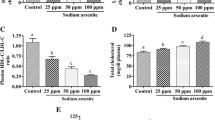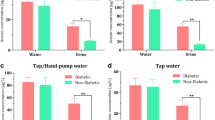Abstract
Populations chronically exposed to arsenic in drinking water often have increased prevalence of diabetes mellitus. The purpose of this study was to compare the glucose homeostasis of male and female rats exposed to low levels of heavy metals in drinking water. Treated groups were Sprague–Dawley male and female rats exposed to drinking water from Antofagasta city, with total arsenic of 30 ppb and lead of 53 ppb for 3 months; control groups were exposed to purified water by reverse osmosis. The two treated groups in both males and females showed arsenic and lead in the hair of rats. The δ-aminolevulinic acid dehydratase was used as a sensitive biomarker of arsenic toxicity and lead. The activity of δ-aminolevulinic acid dehydratase was reduced only in treated male rats, compared to the control group. Treated males showed a significantly sustained increase in blood glucose and plasma insulin levels during oral glucose tolerance test compared to control group. The oral glucose tolerance test and the homeostasis model assessment of insulin resistance demonstrated that male rats were insulin resistant, and females remained sensitive to insulin after treatment. The total cholesterol and LDL cholesterol increased in treated male rats vs. the control, and triglyceride increased in treated female rats vs. the control. The activity of intestinal Na+/glucose cotransporter in male rats increased compared to female rats, suggesting a significant increase in intestinal glucose absorption. The findings indicate that exposure to low levels of arsenic and lead in drinking water could cause gender differences in insulin resistance.





Similar content being viewed by others
References
Carrasco EP, Perez FB, Angel BB, Albala CB, Santos JL, Larenas GY, Montalvo DV (2004) Prevalence of type 2 diabetes and obesity in two Chilean aboriginal populations living in urban zones. Rev Med Chil 132(10):1189–1197
Rahman M, Tondel M, Ahmad SA, Axelson O (1998) Diabetes mellitus associated with arsenic exposure in Bangladesh. Am J Epidemiol 148(2):198–203
Coronado-Gonzalez JA, Del Razo LM, Garcia-Vargas G, Sanmiguel-Salazar F, Escobedo-de la Pena J (2007) Inorganic arsenic exposure and type 2 diabetes mellitus in Mexico. Environ Res 104(3):383–389
Lai MS, Hsueh YM, Chen CJ, Shyu MP, Chen SY, Kuo TL, Wu MM, Tai TY (1994) Ingested inorganic arsenic and prevalence of diabetes mellitus. Am J Epidemiol 139(5):484–492
Patrick L (2006) Lead toxicity, a review of the literature. Part 1: exposure, evaluation, and treatment. Altern Med Rev 11(1):2–22
Palacios J, Cifuentes F, Stegen S (2007) Chronic ingestion of arsenic (< 40 mu M) in tap water impairs vascular endothelium response in aorta of female rats. Clin Exp Hypertens 29(2):98–98
Cifuentes F, Bravo J, Norambuena M, Stegen S, Ayavire A, Palacios J (2009) Chronic exposure to arsenic in tap water reduces acetylcholine-induced relaxation in the aorta and increases oxidative stress in female rats. Int J Toxicol 28(6):534–541
WHO (2004) Guidelines for drinking-water quality. World Health Organization, Geneva
Sepulveda V, Vega J, Delgado I (2000) Severe exposure to environmental lead in a child population in Antofagasta, Chile. Rev Med Chil 128(2):221–232
Queirolo F, Stegen S, Mondaca J, Cortes R, Rojas R, Contreras C, Munoz L, Schwuger MJ, Ostapczuk P (2000) Total arsenic, lead, cadmium, copper, and zinc in some salt rivers in the northern Andes of Antofagasta, Chile. Sci Total Environ 255(1–3):85–95
Walton FS, Harmon AW, Paul DS, Drobna Z, Patel YM, Styblo M (2004) Inhibition of insulin-dependent glucose uptake by trivalent arsenicals: possible mechanism of arsenic-induced diabetes. Toxicol Appl Pharmacol 198(3):424–433
Paul DS, Walton FS, Saunders RJ, Styblo M (2011) Characterization of the impaired glucose homeostasis produced in C57BL/6 mice by chronic exposure to arsenic and high-fat diet. Environ Health Perspect 119(8):1104–1109
Drobna Z, Walton FS, Paul DS, Xing W, Thomas DJ, Styblo M (2011) Metabolism of arsenic in human liver: the role of membrane transporters. Arch Toxicol 84(1):3–16
Boquist L, Boquist S, Ericsson I (1988) Structural beta-cell changes and transient hyperglycemia in mice treated with compounds inducing inhibited citric acid cycle enzyme activity. Diabetes 37(1):89–98
Fujii Y, Kaizuka M, Hashida F, Maruo J, Sato E, Yasuda H, Kurokawa T, Ishibashi S (1991) Insulin regulates Na+/glucose cotransporter activity in rat small intestine. Biochim Biophys Acta 1063(1):90–94
Ferraris RP, Diamond J (1997) Regulation of intestinal sugar transport. Physiol Rev 77(1):257–302
Khan JM, Wingertzahn MA, Teichberg S, Vancurova I, Harper RG, Wapnir RA (2000) Development of the intestinal SGLT1 transporter in rats. Mol Genet Metab 69(3):233–239
Welz B, Melcher M (1985) Decomposition of marine biological tissues for determination of arsenic, selenium, and mercury using hydride-generation and cold-vapor atomic absorption spectrometries. Anal Chem 57(2):427–431
Pickavance LC, Wilding JP (2007) Effects of S 15511, a therapeutic metabolite of the insulin-sensitizing agent S 15261, in the Zucker Diabetic Fatty rat. Diabetes Obes Metab 9(1):114–120
Cardoso AR, Carvalho CR, Velloso LA, Brenelli SL, Saad MJ, Carvalheira JB (2005) Effect of thiopental, pentobarbital and diethyl ether on early steps of insulin action in liver and muscle of the intact rat. Life Sci 76(20):2287–2297
Diehl KH, Hull R, Morton D, Pfister R, Rabemampianina Y, Smith D, Vidal JM, van de Vorstenbosch C (2001) A good practice guide to the administration of substances and removal of blood, including routes and volumes. J Appl Toxicol 21(1):15–23
Warren MJ, Cooper JB, Wood SP, Shoolingin-Jordan PM (1998) Lead poisoning, haem synthesis and 5-aminolaevulinic acid dehydratase. Trends Biochem Sci 23(6):217–221
Mittal M, Flora SJ (2006) Effects of individual and combined exposure to sodium arsenite and sodium fluoride on tissue oxidative stress, arsenic and fluoride levels in male mice. Chem Biol Interact 162(2):128–139
Berlin A, Schaller KH (1974) European standardized method for the determination of delta-aminolevulinic acid dehydratase activity in blood. Z Klin Chem Klin Biochem 12(8):389–390
Diez N, Barber A, Ponz F (1992) Role of -SH groups in rat sugar intestinal transport in vivo. Rev Esp Fisiol 48(2):127–132
Kim Y, Lee BK (2011) Association between urinary arsenic and diabetes mellitus in the Korean general population according to KNHANES 2008. Sci Total Environ 409(19):4054–4062
Steinmaus C, Yuan Y, Liaw J, Smith AH (2009) Low-level population exposure to inorganic arsenic in the United States and diabetes mellitus: a reanalysis. Epidemiology 20(6):807–815
Lin JL, Lin-Tan DT, Hsu KH, Yu CC (2003) Environmental lead exposure and progression of chronic renal diseases in patients without diabetes. N Engl J Med 348(4):277–286
Tsaih SW, Korrick S, Schwartz J, Amarasiriwardena C, Aro A, Sparrow D, Hu H (2004) Lead, diabetes, hypertension, and renal function: the normative aging study. Environ Health Perspect 112(11):1178–1182
Chen CJ, Hsu LI, Wang CH, Shih WL, Hsu YH, Tseng MP, Lin YC, Chou WL, Chen CY, Lee CY, Wang LH, Cheng YC, Chen CL, Chen SY, Wang YH, Hsueh YM, Chiou HY, Wu MM (2005) Biomarkers of exposure, effect, and susceptibility of arsenic-induced health hazards in Taiwan. Toxicol Appl Pharmacol 206(2):198–206
Lesage FX, Deschamps F, Millart H (2010) Lead levels in fur of rats treated with inorganic lead measured by inductively coupled argon plasma mass spectrometry. Interdiscip Toxicol 3(4):118–121
Subcommittee on Arsenic in Drinking Water NRC (1999) Arsenic in drinking water. The National Academies, Washington, DC
Vahter M, Akesson A, Liden C, Ceccatelli S, Berglund M (2007) Gender differences in the disposition and toxicity of metals. Environ Res 104(1):85–95
Vahter M, Concha G (2001) Role of metabolism in arsenic toxicity. Pharmacol Toxicol 89(1):1–5
Hopenhayn C, Huang B, Christian J, Peralta C, Ferreccio C, Atallah R, Kalman D (2003) Profile of urinary arsenic metabolites during pregnancy. Environ Health Perspect 111(16):1888–1891
Lindberg AL, Ekstrom EC, Nermell B, Rahman M, Lonnerdal B, Persson LA, Vahter M (2008) Gender and age differences in the metabolism of inorganic arsenic in a highly exposed population in Bangladesh. Environ Res 106(1):110–120
Kitchin KT (2001) Recent advances in arsenic carcinogenesis: modes of action, animal model systems, and methylated arsenic metabolites. Toxicol Appl Pharmacol 172(3):249–261
Dopp E, von Recklinghausen U, Diaz-Bone R, Hirner AV, Rettenmeier AW (2011) Cellular uptake, subcellular distribution and toxicity of arsenic compounds in methylating and non-methylating cells. Environ Res 110(5):435–442
Hevener A, Reichart D, Janez A, Olefsky J (2002) Female rats do not exhibit free fatty acid-induced insulin resistance. Diabetes 51(6):1907–1912
Fujita Y, Kojima H, Hidaka H, Fujimiya M, Kashiwagi A, Kikkawa R (1998) Increased intestinal glucose absorption and postprandial hyperglycaemia at the early step of glucose intolerance in Otsuka Long-Evans Tokushima Fatty rats. Diabetologia 41(12):1459–1466
Dyer J, Wood IS, Palejwala A, Ellis A, Shirazi-Beechey SP (2002) Expression of monosaccharide transporters in intestine of diabetic humans. Am J Physiol Gastrointest Liver Physiol 282(2):G241–G248
Izquierdo-Vega JA, Soto CA, Sanchez-Pena LC, De Vizcaya-Ruiz A, Del Razo LM (2006) Diabetogenic effects and pancreatic oxidative damage in rats subchronically exposed to arsenite. Toxicol Lett 160(2):135–142
Paul DS, Devesa V, Hernandez-Zavala A, Adair BM, Walton FS, Drobna Z, Thomas DJ, Styblo M (2008) Environmental arsenic as a disruptor of insulin signaling. Met Ions Biol Med 10:1–7
Pysher MD, Sollome JJ, Regan S, Cardinal TR, Hoying JB, Brooks HL, Vaillancourt RR (2007) Increased hexokinase II expression in the renal glomerulus of mice in response to arsenic. Toxicol Appl Pharmacol 224(1):39–48
Moriya R, Shirakura T, Ito J, Mashiko S, Seo T (2009) Activation of sodium-glucose cotransporter 1 ameliorates hyperglycemia by mediating incretin secretion in mice. Am J Physiol Endocrinol Metab 297(6):E1358–E1365
Acknowledgments
We would like to thank Blanca Alvarez Carvajal from Laboratorio Clínico Hormonal RadioLab, Laboratorio Clínico Blanco for the technical assistance in this study. This work was in part supported by grants from Fondo Interno de Investigación Científica de la Universidad Católica del Norte (DGIP 220203-10301206) and Dirección General de Investigación (DIRINV 1339-2007) de la Universidad de Antofagasta.
Author information
Authors and Affiliations
Corresponding author
Rights and permissions
About this article
Cite this article
Palacios, J., Roman, D. & Cifuentes, F. Exposure to Low Level of Arsenic and Lead in Drinking Water from Antofagasta City Induces Gender Differences in Glucose Homeostasis in Rats. Biol Trace Elem Res 148, 224–231 (2012). https://doi.org/10.1007/s12011-012-9355-3
Received:
Accepted:
Published:
Issue Date:
DOI: https://doi.org/10.1007/s12011-012-9355-3




